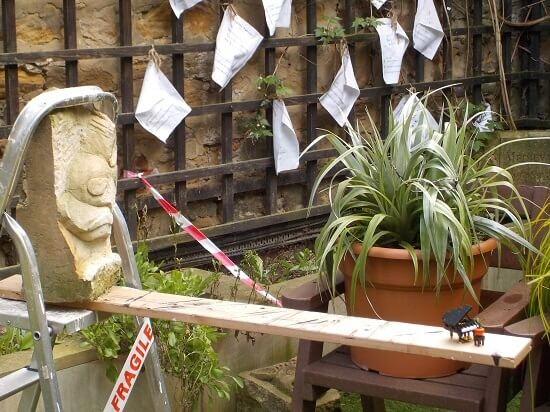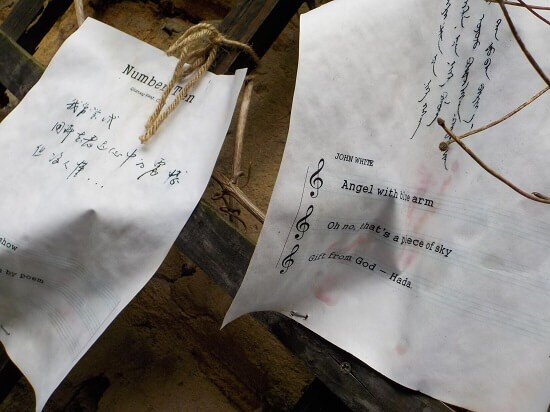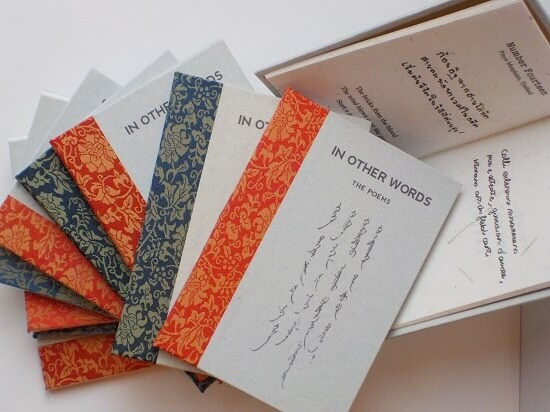In Other Words, a collaborative art and sound installation, was conceived and created by artist Alan O'Cain with the help of Durham's international and local community to celebrate the 30th Anniversary of Durham's UNESCO World Heritage status. The installation was open to the public from January until March 2017 at the World Heritage Site Visitor Centre, a stone's throw from Durham's magnificent cathedral.
Thirty international postgraduate students from Durham University spent an afternoon with Alan writing haiku poems, gaining inspiration from a walk around the city. The haikus were then recorded - recited by the students in their original languages and again in English by randomly selected members of the Durham public, set to an original piano score composed by Neil Crimes. This recording was used as a soundscape for the outdoor installation which featured found-object sculpture, pot plants, astroturf, a nanobloc miniature grand piano and the printed haikus. It was installed with the help of Mike Hughes, Durham Botanic Garden head gardener, and his team. The haikus were also published in a limited edition handmade book.
The slideshow above contains photographs taken as the students walked around the city with extracts from their haikus overlaying the images. If your brower allows, the soundtrack is playing now; if not, press the play button on the audioplayer below. There is an 'interactive wall' below containing the poets, haikus and speakers and a statement from each member of the project team.
In an historic courtyard garden, a tiny piano, played by a tiny model pot plant, rests precariously on the end of a long plank, counterweighted by a heavy stone. Poems, like leaves, droop on the trellis. Real plants are the concert audience, lodged in the surrounding chairs. The sound of words and music wafts on the air.
Listen to the installation soundtrack:



Browse the poets & speakers and statements from the installation creative team:
-
best viewed on larger screens
Hover/tap a poet to read their haiku!
SORT:Yuxuan Zhang
Poet No.1
Stephen Joslyn
Speaker No.1
Fengfei Hou
Poet No.2
Shirley Brotherton
Speaker No.2
Zheng Yanmin
Poet No.3
Garry Skuse
Speaker No.3
Zhao Xuexue
Poet No.4
Jane Parker
Speaker No.4
Di Zhao
Poet No.5
Chris Hayes
Speaker No.5
Cheng-Fen Feng
Poet No.6
Scott Atkinson
Speaker No.6
Hang Zhou
Poet No.7
Emma Turnbull
Speaker No.7
Wenjun Jiang
Poet No.8
Mackenzie Young
Speaker No.8
Xueqian Ma
Poet No.9
Andrew Lowther
Speaker No.9
Quirong Wang
Poet No.10
Debra Miller
Speaker No.10
Yao Song
Poet No.11
Alison Weavers
Speaker No.11
Yuwei Hu
Poet No.12
Debbie Milburn
Speaker No.12
Lianghui Tseng
Poet No.13
Mark Wilson
Speaker No.13
Pinyo Meephiam
Poet No.14
Jim Corr
Speaker No.14
Lucrezia Dalessandro
Poet No.15
S Soppitt
Speaker No.15
Yurie Furuya
Poet No.16
Norma Gibson
Speaker No.16
Anne-Sophie Hardy
Poet No.17
Eileen Hall
Speaker No.17
Aya Saito
Poet No.18
Mari Barton
Speaker No.18
Hee Jae Shin
Poet No.19
James Norman
Speaker No.19
Alan O'Cain
Poet No.20
Ruth Wiltsher
Speaker No.20
Gaurav Kalyani
Poet No.21
John Ward
Speaker No.21
Shi Qiaoyu
Poet No.22
Anum Dada
Speaker No.22
Lin Jiahe
Poet No.23
Alice Stamataki
Speaker No.23
Wu Xiaoyu
Poet No.24
Norah Wright
Speaker No.24
Chao Yang
Poet No.25
Pam White
Speaker No.25
Hu Jiadi
Poet No.26
Geoff Wright
Speaker No.26
Chao Ouerle
Poet No.27
John White
Speaker No.27
Xinzhe Gu
Poet No.28
Brooke Smith
Speaker No.28
Haruna Tsutsumi
Poet No.29
Annabel Renwick
Speaker No.29
Jasper Sole
Poet No.30
Hollie Codling
Speaker No.30
What is heritage? It is something more than can be seen, touched or heard. With this installation the ungraspable is enwrapped, physically enshrouded, obscured in translation. I am grateful to the international postgraduate student volunteers who spent a precious afternoon exploring the Durham UNESCO World Heritage Site and creating responses to their feelings as haiku poems. I am grateful to the inhabitants of Durham and visitors who recited the English versions of the poems for our soundtrack. I am grateful to Mike Hughes from Durham Botanic Garden for horticultural inspiration and supplies, Jane Gibson and all at the World Heritage Site Visitor Centre for letting us loose in their beautiful public space and to my collaborators Neil Crimes and Juliet Lunn.
Installation is a form of art that brings together elements in a specific place. Visitors might find or seek symbolism in those elements. As an artist I shy away from explicit pre-planned symbolism; I’m excited more by a work’s immediate and emotional effect. Collaborating with others multiplies the resources available to intensify that effect. I’m interested to create an immersive theatrical experience for our audience, and to compel visitors to linger, be moved and to wonder.
Collaboration expands the range of materials available for the artist. Poems written or spoken by others can be collaged in ways to heighten both the allure of their sound and the colour of their meaning: painting with words, in this case a democracy of words. Similarly musical and technical elements provided by collaborators extend the available palette. So, the installation as a whole becomes a single work of art, a coherent vision from a shared experience. The task of the artist matches that of the theatre director and stage designer combined. Whether any part of the installation (or any part of any work of conceptual art) is physically fabricated by the artist is irrelevant. The audience pleasure in such art is in stepping into the minds of its creators and for a while succumbing to the gravitational force of an alternative universe.
Alan O'Cain
"I like words. Words are like stones, heavy and solid and every one different, you can feel their shape and their weight on your tongue"
from Lear's Daughters by Elaine Feinstein and the Women's Theatre Group *
The soundscape for this installation attempts to reflect the strange relationship between the solidity of the Durham World Heritage site and the emotive nature of the haikus and performances it inspired - in other words, the coming together of stone and voice.
What struck me most when listening to the sixty voices we had recorded was the emotive power captured in the slightest nuance or vocal inflection of the students and members of the public. As the above quote suggests, you can hear the weight of the words on their tongues and in their hearts. I recall one instance when a woman had to re-record her haiku after its words had brought to mind the memory of her deceased mother. Voices, like stones, can crack and break, too.
Compositionally, I tried to do as little as possible with the piano and music, preferring to highlight and bring out the natural musicality and diversity of the voices. A meandering and sometimes awkward piano line weaves between the haikus, holding them in place (much like the meandering and often awkward afternoon that Alan and I spent approaching members of the public and asking them to recite a haiku they had never seen or heard before, composed a few days prior by a multitude of international students they would probably never meet). Juliet’s perfectly timed rhythmic announcements were another unexpected musical gem.
There was one element, however, which I have tried to consciously incorporate into the soundscape - the unshakeable sensory presence of the large extractor fan which looms over the courtyard of the installation from a neighbouring restaurant. Much like the Castle and the Cathedral looming over the city from all directions, this fan is a constant backdrop to the courtyard and installation, constantly churning out sounds (and delicious smells). To my delight, this is a very musical extractor fan which likes to outline a c-sharp major triad as the day progresses. I have embraced this strange quasi-harmonic and olfactory journey in the soundscape, as too, the ubiquitous presence of the drone which underpins the piano line throughout, similarly altering pitch at odd and somewhat unexpected moments, much like an isorhythmic tenor line from a medieval motet.
Neil Crimes
* Adaptations of Shakespeare, edited by Fischlin and Fortier
Each website is a coming together of content, design, structure and technology. Quite often simple is best - an elegant design and clear layout allows the content to shine. No obfuscation or fancy tricks to distract the visitor or detract from content. But sometimes the content demands something more. At the heart of the In Other Words installation are the words - written and spoken - of sixty volunteers from all over the world. How to present these in an interesting way?
A while ago I came across a plugin, bookmarked it, and hoped that I would find a good reason to use it on a future website. The plugin - MixItUp - is for animated filtering and sorting - "a powerful tool for engaging application UI and data-visualisation". In other words a great way to acknowledge and represent our volunteers in a fun but meaningful way. The finished result is a digital wall - each volunteer is present as a block in the wall. The blocks can be sorted allowing the visitor to discover patterns and connections. I couldn't help thinking of the sandstone blocks in the magnificent edifices throughout the World Heritage Site - each one handcut by a skilled craftsman over 900 years ago and a small masterpiece in its own right.
The other feature on the site is a slideshow containing photographs taken on the day our student volunteers wrote their haikus - a sunny late September afternoon. These and other photographs of the Cathedral and Castle were snapped using a cheap and cheerful Nikon Coolpix S33 camera. These images are overlaid with words extracted from the haikus. If your sound is turned up and your device allows autoplay you will be hearing the installation soundtrack composed by Neil Crimes. As the basis for his haunting and beautiful composition Neil used the voices of our volunteers recorded on an Olympus (VN-741PC) digital voice recorder.
I hope that this multi-sensory experience captures some of the magic and magnificence of Durham's World Heritage Site and of that special afternoon and whets your appetite to visit this special city.
Juliet Lunn
In Other Words is about 30 - the 30 years that have passed by and gone. You can’t go back, it's all behind. Fairly recent in the scheme of things. But that's just it, once a moment has passed it's gone, it's just a memory - what is a memory? Certain objects may help us recall a memory, but to some it will not bring back anything if they had not been there at the time. So some things happen and we might be there to experience them, then time moves forwards and what happens becomes a memory, possibly a change - for example loss of life or an old building being pulled down, possibly something new – for example you have made something that will continue to have a presence. You can’t remember it all, only little bits. How do we filter what we keep as a memory? What can re-trigger an almost forgotten incident? If it's not something that has become an object in the moment and still exists, then what are we leaving behind, once the memory has gone?
The past has of course moulded and shaped the person today, the life experiences have changed us along the journey. In other words what's past is all just in your mind, you can make a record of it, draw a picture, tell a story, write some haiku, store a keepsake but the moment has passed, gone but not forgotten as they say, but when it was real, when it was happening, that’s when feelings were real, these are much harder to recall, pain, laughter, excitement, boring long delays, panic, relief and so on. Often these are shared with others too and reunions can bring back what is almost forgotten.Mike Hughes


















